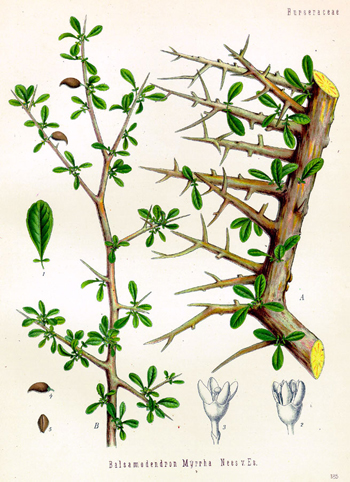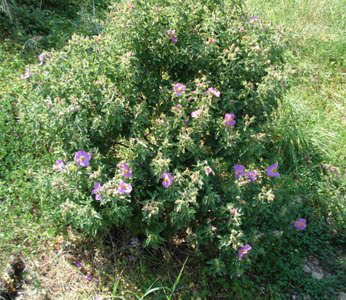Contents:
Common Names | Parts Usually Used | Plant(s) & Culture | Where Found | Medicinal Properties | Biochemical Information
Legends, Myths and Stories | Uses | Formulas or Dosages | How Sold | Warning | Resource Links | Bibliography
Scientific Names

- Commiphora myrrha L.
- Balsamodendron myrrha
- Burseraceae
- Bursera family
Common Names
- Bola (Sanskrit name)
- Gum myrrh tree
- Mu-yao (Chinese name)
Parts Usually Used
The gum resin, powdered gum
Back to Top

Description of Plant(s) and Culture
Myrrh is the aromatic, gummy substance exuded by certain trees and shrubs growing in eastern Africa and Arabia. It can also be found in herb dealer’s stock.
Back to Top
Where Found
Africa and Arabia
Back to Top
Medicinal Properties
Alterative, analgesic, antifungal, antiseptic, astringent, carminative, emmenagogue, expectorant, antispasmodic, disinfectant, immune stimulant, circulatory stimulant, stomachic, tonic, vulnerary
Back to Top
Biochemical Information
An essential oil, resins and gums
Back to Top
Legends, Myths and Stories
Myrrh was one of the precious spices brought to our Lord Jesus when he was born.
One of the earliest records of man’s use of myrrh is found in an Egyptian papyrus dated about 2000 BC. Ancient Egyptian women rid their homes of fleas with myrrh pellets. Myrrh was the main ingredient for the very ancient Egyptian Kyphi incense. Moses was instructed by God to use myrrh as one of the main ingredients in a holy oil for anointing the priests (Exodus 30:22-33). Frankincense and myrrh were the two substances that formed the bases of incense Moses fixed for Jewish ceremonial rites. There are many references in the Bible to myrrh, perhaps the most interesting biblical passages about myrrh are found in the Song of Solomon, where myrrh is compared to the joys of sexual love (Song of Solomon 1:13 and 4:6).
“And when they came into the house, they saw the young child with Mary his mother, and fell down, and worshipped him: and when they had opened their treasures, they presented unto him gifts; gold, and frankincense and myrrh.” St. Matthew 2:11
The name myrrh is derived from the Arabic word mur meaning “bitter”, referring to the spice’s bitter taste.
A legendary account of the origin of myrrh is found in a Syrian myth, which was later adopted by the Greeks. According to this legend, Myrrha, the daughter of the King of Syria, Thesis, refused to worship Aphrodite and was cruelly punished by the goddess, who caused her to commit incest with her father. With the help of her nurse, Myrrha disguised herself and deceived her father for eleven nights, but on the twelfth night Thesis realized who she was. Furious at her, he threatened to kill Myrrha and began chasing her with a knife. To save her, the gods transformed her into a myrrh tree. The clear gum resin exuded by the tree is said to represent Myrrha’s tears.
From remote antiquity, this gum-resin has been used since the Tang Dynasty (AD 600) in Oriental medicines, perfumes, incense, precious ointments, and sacred oils. Originally imported from Persia, it is now produced to some extent in southern China.
Back to Top
Uses
Its uses are similar to those of frankincense, with which it is often combined in liniments and incense. Myrrh is one of the most effective of all known disinfectants. It increases circulation and heart rate.
It is useful for amenorrhea, dysmenorrhea, menopause, uterine tumors, as it purges stagnant blood out of the uterus. Good for obesity and diabetes. The alcoholic extracts of echinacea, myrrh, and mullein are combined to make a medicated oil; an excellent liniment for bruises, aches and sprains is made from a combination of equal parts of myrrh, goldenseal, and cayenne, macerated in rubbing alcohol for about two weeks. Myrrh is commonly used in Chinese medicine for rheumatism, arthritis and circulatory problems.
Myrrh makes a good gargle and mouthwash for sores in the mouth, denture irritated mouth, and throat, diphtheria, sore teeth and gums, coughs, colds, stomach flu, asthma, anemia, and other chest problems. Apply tincture of myrrh full strength to cold sores. It can also be taken internally for bad breath, pyorrhea and for loose teeth and weak gums. Its disinfectant properties make myrrh suitable as a wash for sores, fungal infections, traumatic injuries and wounds, piles, old ulcers, bedsores, and also as a douche. Add myrrh powder to the sore or wound after washing for continued disinfectant activity. Cleans the colon and brings order to the digestive system. Sinus problems that have been with people for years have improved with the use of myrrh.
Studies suggest that myrrh stimulates the body’s immune system, increasing resistance to infection.
The clear, fragrant gum resin of myrrh has been used since ancient times as an incense, as an ingredient in cosmetics and perfumes, as a fumigant, and in embalming.
Back to Top
Formulas or Dosages
Infusion: steep 1 tsp. myrrh in 1 pint boiling water for a few minutes and strain. For bad breath, add 1 tsp. goldenseal. Take 1 tsp., 5-6 times a day.
Gargle: steep 1 tsp. myrrh and 1 tsp. boric acid in 1 pint boiling water. Let stand 30 minutes and strain.
Extract: mix 2 to 5 drops in water for an excellent mouthwash.
Use the powdered resin as a tooth powder to brush the teeth.
Tincture: take 2-5 drops at a time, as needed.
Back to Top
How Sold
- Capsules
- Tincture
- Powder
Warning
Any resins tend to be difficult to eliminate and can cause minor damage to the kidneys if taken internally over an extended period. Very high doses, taken over a long period of time can be dangerous. Do not exceed the recommended dose. Do not use if pregnant or have kidney disease without first checking with the doctor. Myrrh is a uterine stimulant.
Back to Top
Resource Links
Herbs That are More Effective in Treating Lyme Than Antibiotics
Back to Top
Bibliography
![]() The Herb Book
The Herb Book, by John Lust, Bantam Books, 666 Fifth Avenue, New York, NY. copyright 1974.
![]() The Herbalist Almanac
The Herbalist Almanac, by Clarence Meyer, Meyerbooks, publisher, PO Box 427, Glenwood, Illinois 60425, copyright 1988, fifth printing, 1994
![]() Planetary Herbology
Planetary Herbology, by Michael Tierra, C.A., N.D., O.M.D., Lotus Press, PO Box 325, Twin Lakes. WI 53181., Copyright 1988, published 1992
![]() American Folk Medicine
American Folk Medicine, by Clarence Meyer, Meyerbooks, publisher, PO Box 427, Glenwood, Illinois 60425, 1973
![]() Back to Eden
Back to Eden, by Jethro Kloss; Back to Eden Publishing Co., Loma Linda, CA 92354, Original copyright 1939, revised edition 1994
![]() Indian Herbalogy of North America
Indian Herbalogy of North America, by Alma R. Hutchens, Shambala Publications, Inc., Horticultural Hall, 300 Massachusetts Avenue, Boston, Massachusetts 02115, 1973
![]() Chinese Medicinal Herbs
Chinese Medicinal Herbs, compiled by Shih-Chen Li, Georgetown Press, San Francisco, California, 1973.
 Old Ways Rediscovered
Old Ways Rediscovered, by Clarence Meyer, Meyerbooks, publisher, PO Box 427, Glenwood, Illinois 60425, published from 1954, print 1988
 Earl Mindell’s Herb Bible
Earl Mindell’s Herb Bible, by Earl Mindell, R.Ph., Ph.D., Simon & Schuster/Fireside, Rockefeller Center 1230 Avenue of the Americas, New York, New York 10020
 Secrets of the Chinese Herbalists
Secrets of the Chinese Herbalists, by Richard Lucas, Parker Publishing Company, Inc., West Nyack, NY, 1987.
![]() The Complete Medicinal Herbal
The Complete Medicinal Herbal, by Penelope Ody, Dorling Kindersley, Inc, 232 Madison Avenue, New York, NY 10016, First American Edition, copyright 1993
![]() Webster’s New World Dictionary
Webster’s New World Dictionary, Third College Edition, Victoria Neufeldt, Editor in Chief, New World Dictionaries: A Division of Simon & Schuster, Inc., 15 Columbus Circle, New York, NY 10023
 A Useful Guide to Herbal Health Care
A Useful Guide to Herbal Health Care, HCBL (Health Center for Better Living).,1414 Rosemary Lane, Naples, FL 34103., Special Sale Catalog, 1996
![]() The Yoga of Herbs: An Ayurvedic Guide to Herbal Medicine
The Yoga of Herbs: An Ayurvedic Guide to Herbal Medicine, by Dr. David Frawley & Dr. Vasant Lad, Lotus Press, Twin Lakes, Wisconsin, Second edition, 1988.
 The Rodale Herb Book: How to Use, Grow, and Buy Nature’s Miracle Plants (An Organic gardening and farming book)
The Rodale Herb Book: How to Use, Grow, and Buy Nature’s Miracle Plants (An Organic gardening and farming book), edited by William H. Hylton, Rodale Press, Inc. Emmaus, PA, 18049., 1974
